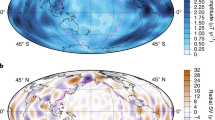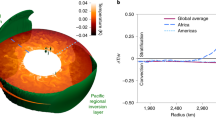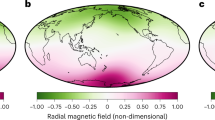Abstract
Tidal heating of a solid planetary body occurs by viscous dissipation, depending on its internal structure1,2,3,4,5 and thermal5,6,7,8 and orbital6,7,8,9 states. Calculations of the response of the Moon to tidal forces have considered lunar interior structure1,2,3,4,5, but have not reproduced the geodetically observed dependence of dissipation on the lunar tidal period10. The attenuation of seismic waves in the deep lunar interior11,12 is expected to be consistent with a low-viscosity layer at the core–mantle boundary, which may explain the observed frequency dependence13. Here we numerically simulate the viscoelastic tidal response of a Moon that contains a low-viscosity layer at the core–mantle boundary and compare with geodetic observations10,14,15. In our simulations, a layer with a viscosity of about 2 × 1016 Pa s leads to frequency-dependent tidal dissipation that matches tidal dissipation measurements at both monthly and annual periods. Compared with the lunar asthenosphere, the calculated viscosity is extremely low, and suggests partial melting at the lunar core–mantle boundary. We also find that tidal dissipation is not evenly distributed in the lunar interior, but localized within the low-viscosity layer, which implies that this layer may act as a thermal blanket16 on the lunar core and influence the Moon’s thermal evolution.
This is a preview of subscription content, access via your institution
Access options
Subscribe to this journal
Receive 12 print issues and online access
$259.00 per year
only $21.58 per issue
Buy this article
- Purchase on Springer Link
- Instant access to full article PDF
Prices may be subject to local taxes which are calculated during checkout


Similar content being viewed by others
References
Ross, M. & Schubert, G. Tidal dissipation in a viscoelastic planet. J. Geophys. Res. 91, D447–D452 (1986).
Khan, A., Mosegaard, K., Williams, J. G. & Lognonné, P. Does the Moon possess a molten core? Probing the deep lunar interior using results from LLR and Lunar Prospector. J. Geophys. Res. 109, E09007 (2004).
Khan, A. & Mosegaard, K. Further constraints on the deep lunar interior. Geophys. Res. Lett. 32, L22203 (2005).
Efroimsky, M. Bodily tides near spin-orbit resonances. Celest. Mech. Dyn. Astron. 112, 283–330 (2012).
Nimmo, F., Faul, U. H. & Garnero, E. J. Dissipation at tidal and seismic frequencies in a melt-free Moon. J. Geophys. Res. 117, E09005 (2012).
Peale, S. J. & Cassen, P. Contribution of tidal dissipation to lunar thermal history. Icarus 36, 245–269 (1978).
Ross, M. N. & Schubert, G. Evolution of the lunar orbit with temperature-dependent and frequency-dependent dissipation. J. Geophys. Res. 94, 9533–9544 (1989).
Meyer, J., Elkins-Tanton, L. & Wisdom, J. Coupled thermal-orbital evolution of the early Moon. Icarus 208, 1–10 (2010).
Bills, B. G. & Ray, R. D. Lunar orbital evolution: A synthesis of recent results. Geophys. Res. Lett. 26, 3045–3048 (1999).
Williams, J. G., Boggs, D. H., Yoder, C. F., Ratcliff, J. T. & Dickey, J. O. Lunar rotational dissipation in solid body and molten core. J. Geophys. Res. 106, 27933–27968 (2001).
Nakamura, Y. et al. New seismic data on state of deep lunar interior. Science 181, 49–51 (1973).
Nakamura, Y. Farside deep moonquakes and deep interior of the Moon. J. Geophys. Res. 110, E01001 (2005).
Nakada, M. & Karato, S. Low viscosity of the bottom of the Earth’s mantle inferred from the analysis of Chandler wobble and tidal deformation. Phys. Earth Planet. Inter. 192, 68–80 (2012).
Goossens, S. et al. Lunar gravity field determination using SELENE same-beam differential VLBI tracking data. J. Geod 85, 205–228 (2011).
Yan, J. G. et al. CEGM02: An improved lunar gravity model using Chang’E-1 orbital tracking data. Planet. Space Sci. 62, 1–9 (2012).
Stegman, D. R., Jellinek, A. M., Zatman, S. A., Baumgardner, J. R. & Richards, M. A. An early lunar core dynamo driven by thermochemical mantle convection. Nature 421, 143–146 (2003).
Dickey, J. O. et al. Lunar laser ranging: A continuing legacy of the Apollo program. Science 265, 482–490 (1994).
Weber, R. C., Lin, P-Y., Garnero, E. J., Williams, Q. & Lognonné, P. Seismic detection of the lunar core. Science 331, 309–312 (2011).
Van Kan Parker, M. et al. Neutral buoyancy of titanium-rich melts in the deep lunar interior. Nature Geosci. 5, 186–189 (2012).
Kamata, S., Sugita, S. & Abe, Y. A new spectral calculation scheme for long-term deformation of Maxwellian planetary bodies. J. Geophys. Res. 117, E02004 (2012).
Moore, W. B. Tidal heating and convection in Io. J. Geophys. Res. 108, 5096 (2003).
Garcia, R. F., Gagnepain-Beyneix, J., Chevrot, S. & Lognonné, P. Very preliminary reference Moon model. Phys. Earth Planet. Inter 188, 96–113 (2011).
Spohn, T., Konrad, W., Breuer, D. & Ziethe, R. The longevity of lunar volcanism: Implications of thermal evolution calculations with 2D and 3D mantle convection models. Icarus 149, 54–65 (2001).
Renner, J., Evans, B. & Hirth, G. On the rheologically critical melt fraction. Earth Planet. Sci. Lett. 181, 585–594 (2000).
Moore, W. B. The thermal state of Io. Icarus 154, 548–550 (2001).
Lainey, V., Arlot, J. E., Karatekin, Ö. & Van Hoolst, T. Strong tidal dissipation in Io and Jupiter from astrometric observations. Nature 459, 957–959 (2009).
Hess, P. C. & Parmentier, E. M. A model for the thermal and chemical evolution of the Moon’s interior: Implications for the onset of mare volcanism. Earth Planet. Sci. Lett. 134, 501–514 (1995).
Zhong, S. J., Parmentier, E. M. & Zuber, M. T. A dynamic origin for the global asymmetry of lunar mare basalts. Earth Planet. Sci. Lett. 177, 131–140 (2000).
Sugano, T. & Heki, K. Isostasy of the Moon from high-resolution gravity and topography data: Implication for its thermal history. Geophys. Res. Lett. 31, L24703 (2004).
Namiki, N. et al. Farside gravity field of the Moon from four-way Doppler measurements of SELENE (Kaguya). Science 323, 900–905 (2009).
Acknowledgements
We thank Y. Abe, K. Heki, S. Honda, H. Hussmann, S. Kamata, S. Karato, M. Nakada, F. Nimmo, E. Ohtani, G. Schubert, H. Shimizu, T. Spohn, L. Xiao, D. Zhao and S. Zhong for critical discussions and W. Moore for a helpful review. Y.H. was financially supported by China Postdoctoral Science Foundation, Chinese Academy of Sciences and National Natural Science Foundation of China.
Author information
Authors and Affiliations
Contributions
Y.H. designed the study and performed the analysis. Y.H. and S.G. wrote the paper. All authors discussed the results and commented on the manuscript.
Corresponding author
Ethics declarations
Competing interests
The authors declare no competing financial interests.
Supplementary information
Rights and permissions
About this article
Cite this article
Harada, Y., Goossens, S., Matsumoto, K. et al. Strong tidal heating in an ultralow-viscosity zone at the core–mantle boundary of the Moon. Nature Geosci 7, 569–572 (2014). https://doi.org/10.1038/ngeo2211
Received:
Accepted:
Published:
Issue Date:
DOI: https://doi.org/10.1038/ngeo2211
This article is cited by
-
The lunar solid inner core and the mantle overturn
Nature (2023)
-
Geophysical evidence for an enriched molten silicate layer above Mars’s core
Nature (2023)
-
Interiors of Earth-Like Planets and Satellites of the Solar System
Surveys in Geophysics (2022)
-
An autonomous lunar geophysical experiment package (ALGEP) for future space missions
Experimental Astronomy (2022)
-
Lunar Seismology: An Update on Interior Structure Models
Space Science Reviews (2019)



